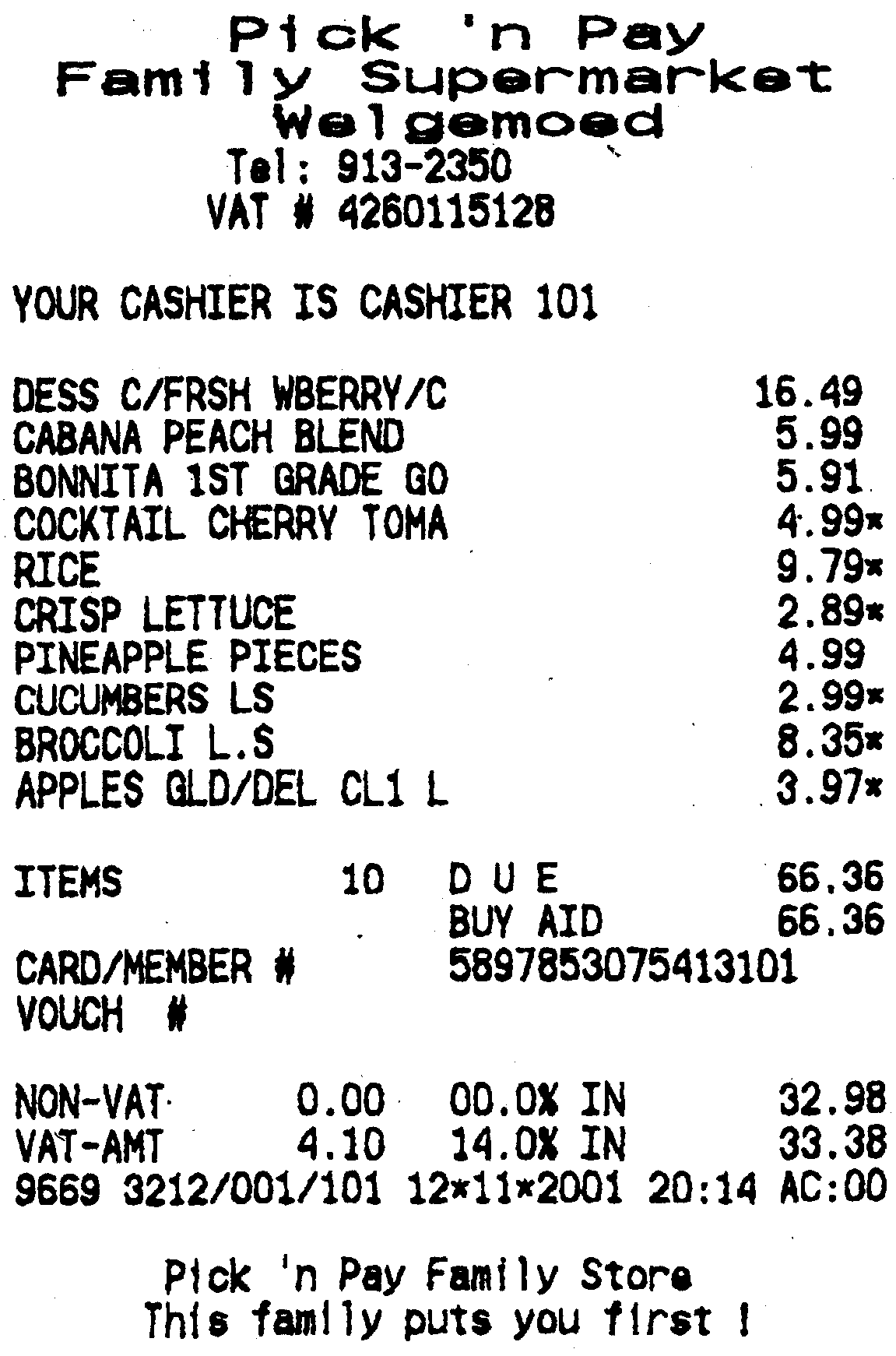| << Chapter < Page | Chapter >> Page > |
1.1 12 November 2001
5 November 2001
1.2 R94,98
1.3 10
1.4 14%
14%
1.5 maps
Cash
1.6 Anneke
1.7 R25,00
1.8 820:14
15:30
2. R9 + R12 + R9 + R4 + R2 + R4 = R40
3.1 1 litre full cream milk
410 g Surf maid peas
200 g Niknaks
5 litre Vanilla ice cream
1 Sasko Sam bread
3.2 Prices will vary from shop to shop
3.3 Calculate according to prices in 3.2
3.4 Calculate according to prices in 3.3
When we buy something in a shop we receive a cash slip. We need to be able to understand and “read” the slip. If not, we will not be able to check if it really reflects what we have bought and paid for. Look at the following examples:
 |
 |
1. Study the above examples and then answer the following questions:
1.1 When were the purchases made at
Pick ’n Pay? ____________________________________________________
Ranch Meat Centre? _____________________________________________
1.2 What does the biltong cost per kg? __________________________________
1.3 How many items were bought from Pick ’n Pay? _______________________
1.4 What % tax had to be paid at
Pick ’n Pay? ____________________________________________________
Ranch Meat Centre? _____________________________________________
1.5 How (with what) did the client pay at
Pick ’n Pay? ___________________________________________________
Ranch Meat Centre? _____________________________________________
1.6 Who was the cashier at Ranch Meat Centre? __________________________
1.7 What amount did the customer give her? _____________________________
1.8 At what time were the purchases made at
Pick ’n Pay? ____________________________________________________
Ranch Meat Centre? _____________________________________________
1.9 If your purchases are not according to the slip, how will you know which cashier helped you at Pick a Pay if you cannot remember what he/she looked like?
_____________________________________________________________________
_____________________________________________________________________
_____________________________________________________________________
1.10 What does the * next to a few of the amounts on the Pick ’n Pay slip mean?
_____________________________________________________________________
_____________________________________________________________________
_____________________________________________________________________
Explain to a friend how we round off to the nearest 10, 100 and 1 000.
** Can you explain how we would round off to the nearest 10 000?
2. When we go shopping, we can estimate to the nearest rand whether we will have enough money to pay.
Look at the following slip. Round off to the nearest rand and estimate how much you will have to pay for your shopping.
| LAMB | |
| 0.360 Kg @ R25.98 / Kg | |
| R9.35 | _____________ |
| LAMB | |
| 0.444 Kg @ R25.98 / Kg | |
| R11.54 | _____________ |
| SWEET CORN R8.79 | _____________ |
| SQUASH | |
| 1.295 Kg @ R3.29 / Kg | |
| R4.26 | _____________ |
| SWEET POTATOES | |
| 0.686 Kg @ R2.99 / Kg | |
| R2.05 | _____________ |
| GOOD MORNING H R3.79 | _____________ |
| COOKED HAM | |
| 0.288 Kg @ R44.95 / Kg | |
| R12.95 | _____________ |
3. Confused Cathy’s shopping list is completely wrong!
3.1 Write the shopping list down correctly.
_____________________________________________________________________
_____________________________________________________________________
_____________________________________________________________________
_____________________________________________________________________
_____________________________________________________________________
_____________________________________________________________________
3.2 Find out what each item will cost at your nearest supermarket and write it down.
_____________________________________________________________________
_____________________________________________________________________
_____________________________________________________________________
_____________________________________________________________________
_____________________________________________________________________
_____________________________________________________________________
3.3 Use your calculator and calculate what this shopping will cost you.
_____________________________________________________________________
_____________________________________________________________________
_____________________________________________________________________
_____________________________________________________________________
3.4 If you pay with a R100 note, how much change will you get?
_____________________________________________________________________
_____________________________________________________________________
_____________________________________________________________________
_____________________________________________________________________
Your calculator has a memory that you can use to do calculations with more than
one operation correctly.
M+ : enables the calculator to save or memorise the answer
MR / RCM : these keys are pressed if you want to retrieve the memorised answers
e.g. (347 219 + 34 987) + (296 553 + 1 897 320)
Key in 347 219 + 34 987 = M+
Then key in 296 553 + 1 897 320 = M+
Then key in MR or RCM
Learning Outcome 1: The learner will be able to recognise, describe and represent numbers and their relationships, and to count, estimate, calculate and check with competence and confidence in solving problems.
Assessment Standard 1.6: We know this when the learner solves problems in context including contexts that may be used to build awareness of other Learning Areas, as well as human rights, social, economic and environmental issues such as:
1.6.1: financial (including buying and selling, profit and loss, simple budgets, reading and interpreting accounts, and discount).

Notification Switch
Would you like to follow the 'Mathematics grade 6' conversation and receive update notifications?